When choosing between thin and thick cooking pots, you'll need to weigh your cooking style. Thin pots respond quickly to temperature changes, making them ideal for precise cooking like sauces and stir-fries. They're perfect when you need rapid heating or quick adjustments. Thick pots, however, distribute heat more evenly and maintain consistent temperatures, making them better for searing, braising, and slow-cooking methods. They prevent hot spots and retain heat longer, though they take more time to heat up initially. Your cooking needs will determine which thickness serves you best, and understanding the science behind these differences can transform your kitchen results.
Material Selection for Solar Cooking

When choosing materials for solar cooking, you'll need to balance several key factors including heat retention, solar absorption, portability, and cost.
Cast iron and ceramic offer excellent heat retention but can be heavy and expensive. For best solar absorption, opt for matte black or dark-colored pots, which you can achieve through black speckleware or flat-black spray paint.
If portability is your priority, lightweight black speckleware provides an ideal balance between absorption and ease of transport. Aluminum pots are also portable but lose heat quickly, so they'll need a dark coating. Box cookers work well with any of these material choices without significantly impacting cooking performance.
For budget-conscious cooking, check thrift shops for black speckled enameled pots. While vacuum-sealed glass tubes offer superior insulation, they're typically more expensive.
Pyrex presents a middle-ground option, offering good heat retention and durability at a reasonable price.
Heat Distribution Properties
You'll notice distinct hot spot patterns when comparing thin and thick cookware, with thin pans developing concentrated heat zones more quickly than their thicker counterparts.
The core heat transfer in thin pans happens rapidly but unevenly, creating temperature variations that can affect your cooking results. This quick response makes thin copper especially advantageous for high-speed sautéing techniques.
Thick-walled pots, especially those with aluminum or copper cores, transfer heat more gradually but maintain more consistent temperatures across their cooking surface.
Hot Spot Formation Patterns
Understanding hot spot formation patterns in cookware reveals a stark contrast between thin and thick pots.
In thin pans, you'll notice that heat travels quickly but often creates problematic hot spots, especially in aluminum and copper cookware. These hot spots can cause uneven cooking, with some areas of your food burning while others remain undercooked. This susceptibility to hot spots makes thin pans more prone to thermal shock warping.
Thick pans, particularly those made of cast iron or quality multiclad stainless steel, distribute heat more gradually and evenly.
While they take longer to heat up, they maintain consistent temperatures across the cooking surface. You won't need to worry as much about localized overheating, making them ideal for tasks like searing.
The slower heat flow in thick materials helps eliminate temperature differentials that typically cause hot spots in thinner cookware.
Core Heat Transfer Dynamics
The core heat transfer dynamics in cookware directly influence hot spot formation and overall cooking performance.
When you're cooking, heat moves through your pot via three mechanisms: conduction from the heat source, convection through air movement, and radiation via electromagnetic waves.
You'll find that materials with high thermal diffusivity, like copper and aluminum, distribute heat quickly and evenly across your cooking surface.
In contrast, stainless steel's low thermal diffusivity means it needs help from better conductors. That's why many high-quality pots combine materials, using stainless steel for durability while incorporating copper or aluminum cores for superior heat distribution.
The thickness of these materials also matters – thicker layers generally provide more even heating, though they'll take longer to heat up initially.
Thin Container Benefits

When you're working with thin cooking pots, you'll notice their superior ability to respond quickly to temperature changes, letting you adjust heat levels with better control.
You'll appreciate how these lightweight containers take up less storage space in your cabinets, making them ideal for kitchens with limited storage.
Their slim profile also means you can stack them more efficiently, maximizing your available cabinet space while maintaining easy access to your cookware.
Quick Temperature Control
Since temperature precision can make or break a dish, thin cooking pots offer superior control over heat adjustments.
You'll find that thinner pans respond quickly when you need to shift from boiling to simmering, making them ideal for liquid-based cooking methods and delicate sauces.
Materials like aluminum and multi-clad stainless steel provide excellent heat conductivity, though you'll need to choose carefully to avoid hot spots.
These pans excel at:
- Rapid temperature adjustments for precise cooking control
- Quick cooling when you need to prevent overcooking
- Even heat distribution with highly conductive metals
While thin pots won't retain heat as well as their thicker counterparts, they're perfect for dishes requiring swift temperature changes.
You'll get the best results using them for soups, sauces, and recipes that demand careful heat management.
Easy Storage Solutions
Thin pots and pans offer remarkable space-saving advantages in your kitchen storage. You'll find these lightweight vessels perfectly suited for vertical storage solutions, whether in pull-out cabinets or on wall-mounted racks. Their slim profile allows you to stack more items in the same space when separated by tea towels or paper towels.
| Storage Method | Thin Pots | Thick Pots |
|---|---|---|
| Vertical Tiers | Fits 6-8 | Fits 3-4 |
| Wall Mounts | Easy to hang | May strain mounts |
| Drawer Space | Multiple layers | Single layer |
You can maximize your cabinet space by installing tiered holders specifically designed for thin cookware. Don't forget to utilize toe-kick drawers and floating shelves for additional storage options. With proper organization systems, you'll keep your thin pots and pans scratch-free while maintaining easy access to your cooking essentials.
Thick Container Advantages
Although many cooks debate pot thickness preferences, thick containers offer compelling advantages that make them worth considering for your kitchen.
These pots excel at heat distribution and retention, ensuring your food cooks evenly without hot spots. You'll find that they maintain consistent temperatures, which is essential for slow-cooking and preparing large meals.
The substantial construction of thick pots provides several key benefits:
- They're incredibly durable, resisting warping, dents, and scratches even with heavy daily use
- You'll get superior heat management thanks to their layered bases, often featuring aluminum or copper cores
- They're versatile enough to handle various cooking methods, from stovetop to oven use, and work well with acidic foods
These features make thick pots a reliable, long-term investment for serious cooking enthusiasts.
Solar Heating Time Differences
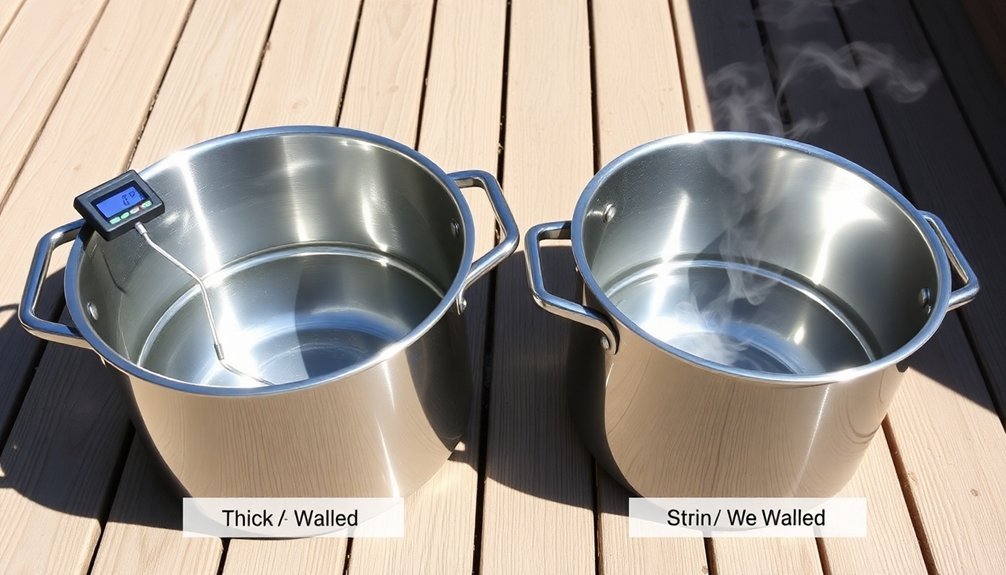
When you're using solar cookers, the thickness of your cooking container greatly impacts heat absorption rates and overall cooking times.
You'll find that thin-walled containers respond more quickly to solar radiation, reaching higher surface temperatures faster than thick-walled ones, though they also lose heat more rapidly.
Your thick-walled pots will take longer to warm up initially but maintain more consistent temperatures throughout the cooking process, making them better suited for longer cooking sessions under variable solar conditions.
Daylight Heat Absorption Rates
Daylight's impact on cooking pot materials reveals fascinating differences in heat absorption rates.
You'll find that metals like copper and aluminum conduct heat remarkably fast, with copper working 500 times more efficiently than clay. When you're cooking in daylight, these differences become essential for temperature control and energy efficiency.
- Copper-clad pots heat up quickest, distributing heat evenly across their surface and reducing your cooking time considerably.
- Clay and glass materials absorb heat slowly but excel at retention, making them ideal for slow-cooking dishes that need steady temperatures.
- Larger solar cookers with sufficient insolated area perform better regardless of material, as they collect more sunlight for effective cooking.
Understanding these absorption rates helps you choose the right pot thickness and material for your specific cooking needs.
Surface Temperature Response Times
Solar energy's effect on pots extends beyond basic heat absorption to their surface temperature response times.
When comparing thin and thick pots, you'll notice distinct differences in how quickly they react to heat changes.
You'll find that thin pots respond rapidly to temperature adjustments, making them ideal for quick-cooking methods where you need immediate heat control. However, they're prone to developing hot spots and don't retain heat well.
In contrast, thick pots take longer to heat up but maintain consistent temperatures and distribute heat more evenly across their surfaces.
For the best cooking results, you'll want to match your pot thickness to your cooking method. Use thin pots for stir-fries and delicate sauces, while thick pots excel at searing and slow-cooking dishes that require stable temperatures.
Warming Speed Comparison Facts
Understanding warming speeds among different cooking materials reveals significant variations in heat conductivity and performance.
You'll find that copper heats up the fastest, conducting heat 500 times faster than clay, while aluminum follows at 100 times faster. These differences directly impact your cooking efficiency and control.
- Copper pots respond almost instantly to temperature changes, making them ideal for precise cooking techniques that require quick adjustments.
- Clay pots heat slowly but retain warmth longer due to their high specific heat rating of 0.33, offering excellent heat distribution for slow-cooking dishes.
- Stainless steel provides a middle ground, heating rapidly and maintaining consistent temperatures across the cooking surface, though cooling quickly once removed from heat.
This understanding helps you choose the right pot for your specific cooking needs, whether it's quick sautéing or slow braising.
Thermal Mass Impact
The thermal mass of a cooking pot plays an essential role in how it performs during meal preparation. When you're choosing between thin and thick pots, understanding thermal mass impact can help you make the right decision for your cooking needs.
| Feature | High Thermal Mass | Low Thermal Mass |
|---|---|---|
| Heat Distribution | Even, consistent heating | Prone to hot spots |
| Temperature Control | Maintains steady temps | Quick temperature changes |
| Energy Efficiency | Better heat retention | Requires more energy input |
High-density materials like cast iron excel at absorbing and storing heat, making them ideal for slow cooking and braising. You'll find these pots distribute heat more evenly, preventing hot spots that can burn your food. They're also more energy-efficient since they maintain cooking temperatures longer, reducing the need for constant heat adjustments.
Container Shape Considerations
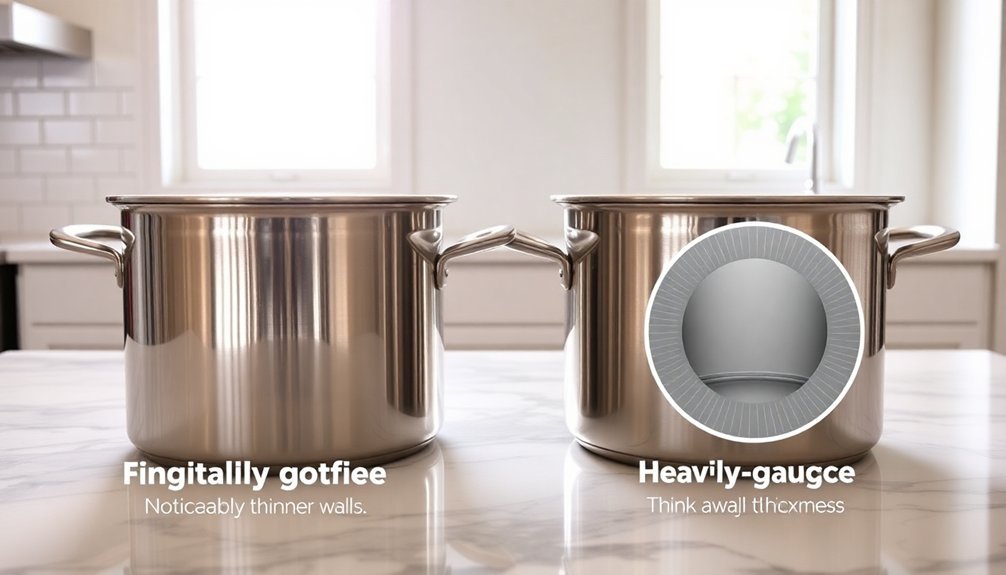
Beyond thermal mass, a pot's shape greatly influences its cooking performance and usability in the kitchen.
Wide pots offer better stability and heat distribution, while narrow ones excel at reducing sauces and simmering liquids. You'll find that different shapes serve distinct cooking purposes, from braising to high-heat cooking.
- Wide, shallow pans like braziers and rondeau pans are perfect for braising meats and vegetables, giving you easy access for stirring.
- Tall, narrow saucepans help you efficiently reduce liquids and make sauces, concentrating flavors effectively.
- Dutch ovens, with their round shape and thick walls, distribute heat evenly for slow-cooking while retaining moisture.
Choose your pot's shape based on your cooking method – wide for even heating and stability, narrow for reduction and simmering, and specialized shapes for specific techniques.
Material Durability Under Sun
Since outdoor cooking exposes pots to intense sunlight and temperature fluctuations, your cookware's material durability becomes essential for long-term performance.
Stainless steel offers superior resistance to corrosion and high temperatures, making it ideal for sun exposure, though you'll need to protect it from thermal shock.
While aluminum is lightweight, you'll want to choose anodized versions for better durability in sunlight, as untreated aluminum can degrade.
Carbon steel requires consistent seasoning maintenance, especially when used outdoors, as sun exposure can compromise its protective layer.
Cast iron, though extremely durable against warping and denting, needs careful storage and seasoning to prevent rust when exposed to the elements.
Its weight makes it less practical for outdoor activities that require mobility.
Food Type Compatibility

Different cooking materials pair best with specific types of food, much like how outdoor durability varies among pot materials.
You'll find stainless steel excels with pasta and soups, while cast iron is your go-to for high-heat cooking and meat searing.
Ceramic cookware handles acidic foods beautifully, and non-stick pots work wonders for low-fat cooking and easy cleanup.
Consider these key compatibility factors when choosing your cookware:
- Stainless steel's nonreactive surface makes it versatile for most dishes, including acidic foods, and it's compatible with induction cooktops
- Cast iron adds beneficial iron to your food but shouldn't be used with acidic ingredients to prevent rusting
- Ceramic offers a toxin-free cooking surface that's perfect for delicate foods and acidic sauces, though it may ring on induction stoves
Temperature Control Methods
While maintaining precise temperatures is essential for cooking success, modern technology offers various methods to control heat effectively in your cookware. You'll find two primary approaches: dimmers and thermostats. Dimmers work like light controls, letting you manually adjust heat flow, while thermostats automatically regulate temperature using probe sensors.
| Method | Control Type | Key Features |
|---|---|---|
| Dimmer | Manual | Continuous heat flow |
| Thermostat | Automatic | Precise regulation |
| Heat Dispersion | Physical | Even distribution |
| Burner Control | Manual | Base temperature |
| Insulation | Passive | Heat retention |
For best results, you can combine these methods. Using a thermostat with proper insulation guarantees stable temperatures, while heat dispersion devices help eliminate hot spots. Remember, thicker cookware naturally maintains steadier temperatures, while thinner pots respond quickly to adjustments.
Frequently Asked Questions
Can Thin Pots Be Safely Stacked During Storage Without Damaging Them?
You shouldn't stack thin pots, as they're easily damaged and scratched. Instead, use vertical organizers, wall hooks, or cabinet racks to store them separately. This prevents surface damage and maintains their quality.
How Does Altitude Affect Cooking Performance in Thin Versus Thick Pots?
At high altitudes, you'll notice thick pots perform better as they retain heat more effectively, while thin pots lose heat quickly. This means longer cooking times in thin pots and more frequent temperature adjustments.
Do Thin or Thick Pots Retain More Vitamins and Nutrients?
You'll retain more nutrients in thicker pots since they provide steadier temperatures and less burning. However, the cooking method and duration matter more than pot thickness for preserving vitamins and minerals.
Which Pot Thickness Works Best With Portable Camping Stoves?
You'll get better performance from thicker pots (around 4mm) on camping stoves. They distribute heat more evenly, prevent hot spots, and maintain stable temperatures. However, consider the weight trade-off for your backpacking needs.
How Does Seasoning Affect the Performance of Different Pot Thicknesses?
You'll find seasoning works better on thick pots, creating a lasting non-stick surface and improved heat distribution. On thin pots, seasoning doesn't last as long and won't greatly enhance their cooking performance.
In Summary
You'll find both thin and thick pots have their place in solar cooking, but your choice should match your needs. Thin pots heat quickly and work well for short-cook items, while thick ones maintain steady temperatures for slow-cooking dishes. Consider your local climate, cooking style, and typical recipes when selecting. Whatever you choose, proper pot placement and material quality will greatly impact your solar cooking success.
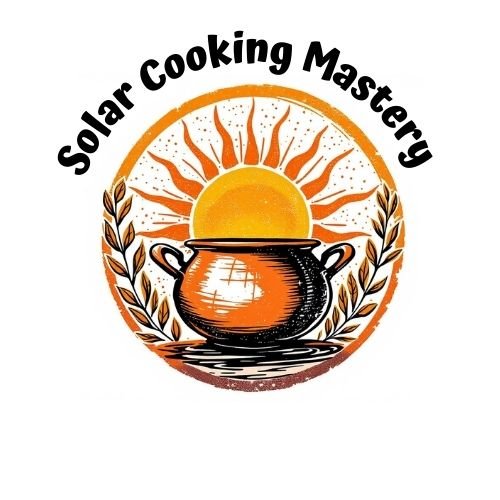

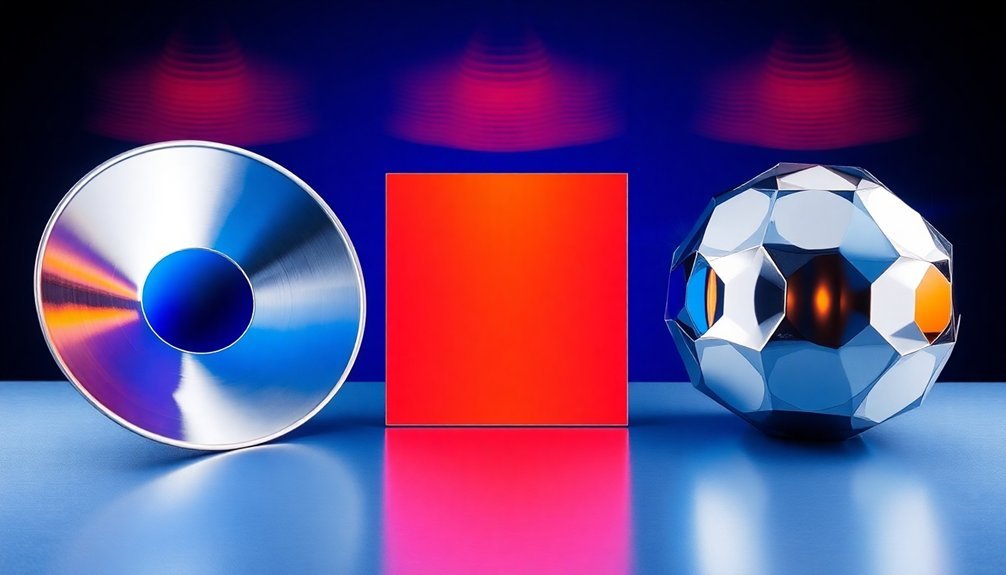
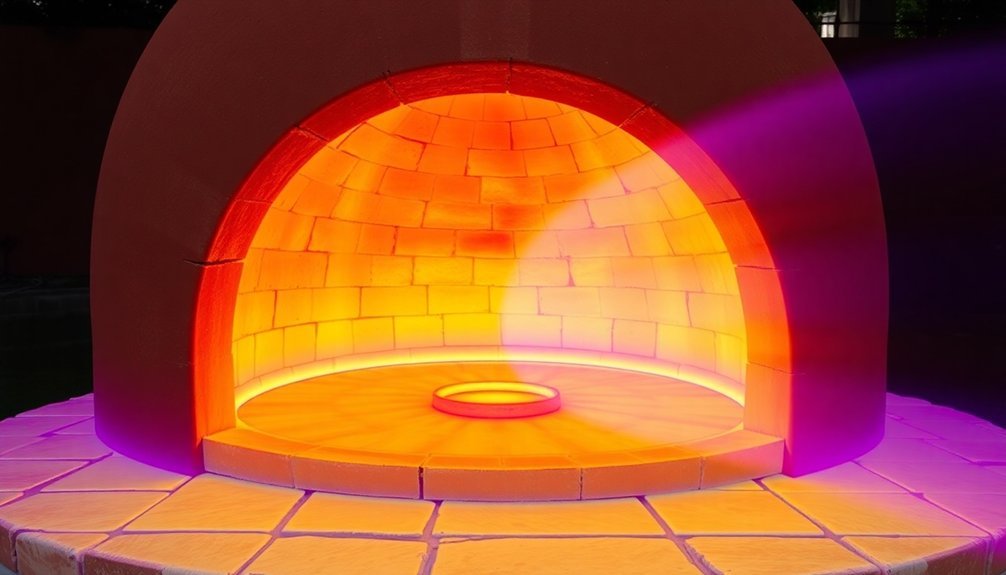

Leave a Reply